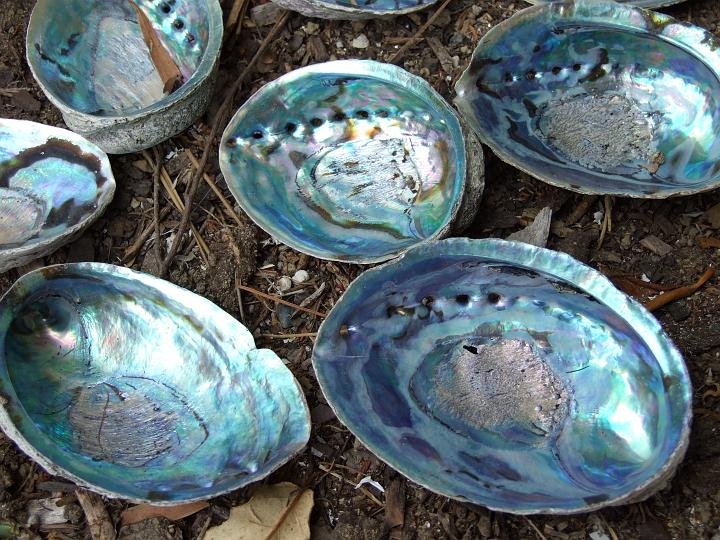|
Pau 1. To run out (food, water): ekó pau te kai, te vai, is said when there is an abundance of food or water, and there is no fear of running out. Puna pau, a small natural well near the quarry where the 'hats' (pukao) were made; it was so called because only a little water could be drawn from it every day and it ran dry very soon. 2. Va'e pau, clubfoot. Paupau: Curved. Vanaga. 1. Hakapau, to pierce (cf. takapau, to thrust into). Pau.: pau, a cut, a wound, bruised, black and blue. 2. Resin. Mq.: epau, resin. Ta.: tepau, gum, pitch, resin. (Paupau) Hakapaupau, grimace, ironry, to grin. 3. Paura (powder), gunpowder. 4. Pau.: paupau, breathless. Ta.: paupau, id. 5. Ta.: pau, consumed, expended. Sa.: pau, to come to an end. Ma.: pau, finished. 6. Ta.: pau, to wet one another. Mq.: pau, to moisten. Churchill. |
|
TRANSLATIONS
The live animals are eye-catching creatures:
 A lined chiton (Tonicella lineata) with head at left and tail end at right in the picture (Ref. Wikipedia). The animal invites to counting: 8 shells it has and the bright yellow spots are arranged with one at the head end and the 7 on each side = 15. The empty shells are not half as beautiful and more reminiscent of the moon than the sun:
 Wikipedia: "... Paua or pāua is the Māori name given to three species of large edible sea snails, marine gastropod molluscs which belong to the family Haliotidae (genus Haliotis), known in the USA as abalone, and in the UK as ormer shells ..." English Etymology explains 'ormer' as derived from the Latin auris maris 'ear of the sea' because of the resemblance to the ear. I reflect on the use of ears in the dark (instead of the eyes), and the whispers of ghosts in sea shells. The Maori name paua we have met before, 'curved', 'black and blue', 'consumed', 'finished', 'come to an end':
The explorers landed at Haga Te Pau, at winter solstice (He Maro 1 according to Barthel 2) in the sacred geography of the island. The empty (pau) sea shell presumably alludes to the expended (pau) 2nd half of the year. Let us now continue with the long series of pages from the hyperlink 'Excursion':
The 'eating hand' sign presumably means 'growing', and that is a natural sign to put into the first glyphs of a season (as in Eb4-5 and Eb5-12). But in the last season the 'eating hand' is in the same glyph as mauga. Possibly it is there in order to show what is 'finished' (according to the closed elbow ornament), viz. the 'growing' stage, and we then should read pau. I investigate if Metoro used the word pau anywhere in his readings (at Eb2-13 he did not: tagata oho - ki moto vaero tae). Only at 4 glyphs was that word used:
Here we immediately note 12-24 and a special variant of vae (which we must remember, because the next 'chapter' in the glyph dictionary is vae). The ordinal numbers agree with vae paupau (= 'definitely finished going', I guess). Next we note that the other three glyphs belong to the glyph type tagata rere. And then, in Eb4-28 (4 * 28 = 112 as in - we remember - the mama glyph Eb5-19) we can see a fully drawn elbow ornament connected to a hand oriented upwards (not a kai hand). The location, in the 16th period, evidently marks the final of summer (and 112 = 16 * 7):
Counting beyond the last glyph of the 1st half (the 'light' mauga in Eb4-4) Eb4-29 (the summer henua) will be number 25, counting from the beginning (the 1st glyph in the 1st period) it will be number 100. Hand held high, oriented upwards, possibly means summer. Although it could, alternatively, here refer to the 3rd quarter of the year. Hand towards mouth (eating sign) ought first of all refer to the 1st and 2nd quarters, I think. In Eb2-13 the eating sign seems to have a more general meaning: 'no more life', 'no more growing'. Another reflection is how an 'eating' (growing) henua indicates the beginning of a season, not only the spring season (rather the opposite, because the two examples arriving immediately beyong the 'light' mauga and the 'moon' mauga' are not located in spring). This type of glyph is rare. Searching through all henua glyphs (so far documented in the glyph catalogue) I find only these examples of henua + arm worthy of mentioning:
|
|||||||||||||||||||||||||||||||||||||||||||||||||||||||||||||||||||||||||||||||||||||||||||||||||||||||||||||||||||||||||||||||||||||||||||||||||||||||||||||||||||||||||||||||||||||||||||||||||||||||||||||||||||||||||||||||||||||||||||||||||||||||||||||||||||||||||||||||||||||||||||||||||||||||||||||||||||||||||||||||||||||||||||||||||

















